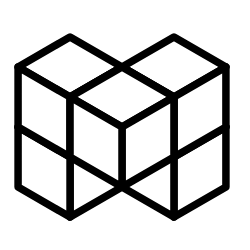Research and development
RESEARCH AND DEVELOPMENT PART OF THE PROJECT
CC STOS provides the most modern conditions for conducting R&D projects, combining science and business
It will also be conducive to establishing cooperation of entities looking for various solutions and entities offering multiple solutions in order to verify approaches and implement innovative solutions.
main areas of research work
6






1
Interdisciplinarity and transdisciplinarity
Solving complex problems requires various approaches resulting from the adopted scope of considerations and the integration of available knowledge. Hence, we distinguish multi-, inter- and trans-disciplinary research.
find out more
Multidisciplinary problems cover the whole range of research related to one or more scientific disciplines, with loosely linked research. On the other hand, interdisciplinary and transdisciplinary research emphasizes a high degree of dependence of research results, both in one and in many disciplines. This is explained in the figure, in which a wide and narrow scope of research may be associated with one discipline or even with the entire field, while the degree of integration is the greater, the greater the research conducted in a given discipline requires a wider use of research results from other disciplines. An example of a transdisciplinary approach may be solving health care problems that require taking into account progress not only in medicine, but also in such sciences as: computer science, economics and management. It is worth emphasizing that the integration of key technologies also requires such an approach. The biggest challenge is the high integration of research in various fields, which is the highest degree of transdisciplinarity.
Advantages of the transdisciplinary approach:
- Closeness to real life problems.
- Ease of adaptation to practice.
- Integration of researchers from various fields, despite the diversity of concepts – their meaning and complexity of description.
- Complex problems can be solved with the use of large-scale computing.
- Understanding the world as entireness.
2
Technology integration
The production of modern services and applications requires a trans-disciplinary approach, which in turn leads to the necessity to simultaneously take into account the capabilities of key information technologies.
find out more
A modern IT service uses the available data and knowledge, which it processes in the computing cloud, using algorithms for mass data analysis and artificial intelligence. In this way, we gain new knowledge through access to data sources – IoE, data collection and unification (BD) as well as their analysis and knowledge extraction (CC, AI). Moreover, this type of services is the basis for building various scenarios for the implementation of complex projects supporting human activity. That is why it is so important to develop modern software engineering methods that enable effective design and production of such services, as well as adequate scenarios for the operation of chains of these services. Competences of this type constitute the basis for the operation of CC STOS. The development of cloud computing and software engineering methods are highlighted below.
Development of the TASKcloud computing cloud
The aim of this task is the continuous development of cloud computing both in terms of the size of available resources and the functional capabilities of layered architecture: IaaS, PaaS and SaaS, in order to develop an effective environment for the production and performance of IT services. The increase in computing resources is associated with the purchase of a supercomputer under the CC STOS project. Further possibilities of increasing the calculations (graphics processors and mass storage systems) will be provided under other projects carried out by CI TASK. The functional possibilities will result from the use of open software related to individual layers of cloud computing.
Development of software engineering methods for the production of cloud services
The use of IT services to build applications requires further development of the SOSE (Service Oriented Software Engineering) methodology, software engineering focused on intelligent services. At the same time, the use of both high-performance computing (HPC) methods as well as artificial intelligence (AI) algorithms and (CC) cloud paradigms should be taken into account. It will also be important to collect and use relevant domain (IoT) and interdisciplinary data, as well as to adopt standard service interfaces enabling the creation of application operation scenarios. This requires the integration of various technologies such as HPC, IoT, CC and AI. This type of approach will be tested by executing several application demonstrators, which are given in the description of the application structure.
3
Production of SMART services
The development of the SOSE (Service Oriented Software Engineering) method leads to the production of SMART services. Their acronym indicates the basic properties of such services.
find out more
The development of the SOSE (Service Oriented Software Engineering) method and the TASKcloud computing cloud, as well as the development of effective methods for the analysis of large data sets will create favorable conditions for the production of intelligent SMART services. SMART services use knowledge from various, even distant research fields, and intelligently react to changes in context. The acronym SMART defines the characteristics of these services, such as:
- S defines “Self-Improving” services, i.e. adapting to changing environmental conditions;
- M points to “Maximum efficient and secure” services for reliable real-time operation;
- A stands for the services “Analyzing huge data sets”;
- R is an additional aspect of services, “Random developing new knowledge”;
- T emphasizes the practical aspect – “creaTed for the needs of users”.
Meeting the above requirements ensures wide usefulness of SMART services in many areas of human life.
4
CI TASK server room
The planned server room includes 7 chambers, each of them can be independently equipped with technical infrastructure, depending on the needs of various types of computing servers or data servers installed.
find out more
The server room meeting the security requirements for at least TIER III / IV will include:
- 2 small chambers: network and tape archives;
- 4 chambers for computers with high computing power;
- 1 chamber, the so-called “secure bunker” for long-term data storage.
The infrastructure produced and purchased under the CC STOS project will be innovative and completely unique on a national scale, both in terms of the construction infrastructure itself and the adopted technical and technological solutions (power supply, cooling, extinguishing systems), as well as in terms of equipment (including supercomputer and servers) and available computing power and data archiving options. As part of this project, three chambers will be partially equipped. The remaining ones will be systematically supplemented, depending on the requirements of other projects implemented by CI TASK.
The final parameters of computer servers (for the year 2023) are:
PFlops for target computing power
InfiniBand (internal communication) will be at least 100 Gbps
4-8 GB RAM per core
It is assumed that the supercomputer’s capabilities will be expanded in the following stages:
- Specification of the hardware infrastructure and supercomputer software purchased under various projects that finance such projects.
- Preparation of the technical infrastructure necessary for the installation of the specified supercomputer under these projects.
- Preparation of the tendering procedure and carrying out the combined tender with purchases of this type in other data centers.
- Finalizing the tender procedure and purchasing a supercomputer, its installation and commissioning in the final environment.
5
Application programs
Presentation of SMART services and applications developed under the CC STOS project in the maritime (shipping route), medical (disease recognition) and social (epidemic spreading) areas.
find out more
a. Tourist Areas Monitoring
The main task is the purchase, installation and commissioning on the network infrastructure of the company Chopin Telewizja Kablowa Sp. z o.o. (CTK) 15 probes (5 CTK + 10 PG)) to monitor environmental parameters, i.e.: air temperature, noise level, wind speed, water temperature, ensuring better image quality and launching a remote service providing this type of information for the community concerned. Problems to be solved concern:
- Choosing the location of the probes – Pomeranian beaches, possibly close to the piers,
- Collecting additional weather information, including water temperature,
- Report preparation on the installation and usability tests of the devices used,
- Adding the monitored information on the website related to these regions (seaside24.pl),
- CC STOS project promotion as a part of the company’s advertising banners.
b. Maritime Logistics Problems
The main task is to create an application / service regarding: “Planning the sailing route in changing sea conditions”. The application is intended for use by sailing amateurs and professional sailors to plan the sailing route, taking into account:
- Choosing a place and sailing period,
- Taking into account sailing conditions, including: weather, wind parameters or sea wave levels,
- Set sailing destination: to sail a specific route while ensuring the required sailing comfort, safety level and optimal sailing time.
- Code optimization possibilities and application execution in a parallel environment on the computing cloud TASKcloud.
- Making the application available to interested parties.
An example of a planned route is as following:

c. Application of artificial intelligence in medicine
The main task is to create an application / service regarding: “The use of intelligent services for the analysis of medical imaging in the diagnosis of social diseases”. The application is designed to analyze various types of medical data imaging, in order to recognize disease anomalies:
- Collection, selection and labeling of reliable medical data.
- Development of an artificial intelligence algorithm to analyze the collected data.
- Giving examples of anomalies recognition and their graphic presentation.
- Preparation of applications recognizing lesions.
- Providing access and implementation of applications in a parallel environment on the TASKCloud computing cloud.
View of the aorta after contrast administration:
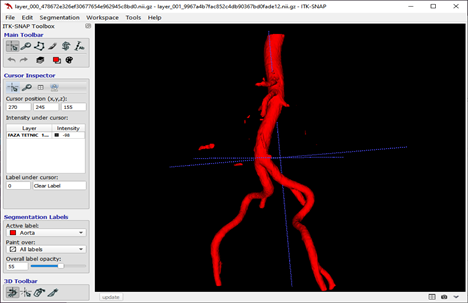
Visualization of aortic aneurysm
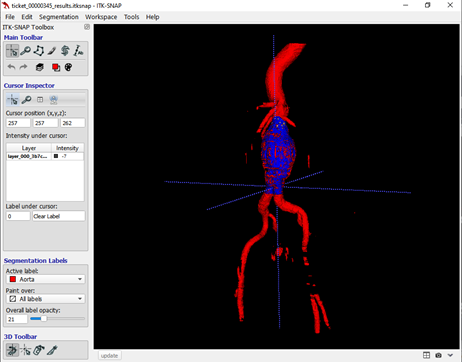
d. The development of the COVID-19 epidemic in various regions of Poland
The main task is to create an application / service regarding: “Mass data analysis on COVID -19 taking into account the specificity of provinces” and to make selected analyzes using the BigData environment:
- Selection of parameters describing the COVID-19 epidemic (rate of disease increase, need for hospital treatment, mortality) and region-specific characteristics: population density, type of economy, level of technological development, social activity, percentage of vaccinated people, etc.
- The use of Big Data technology to create a data repository from point 1 in the computing cloud TASKCloud.
- Design and implementation of services examining the correlations between the parameters of the COVID-19 epidemic and the parameters of regional characteristics.
- Examination of selected correlations for selected Polish voivodeships.
- Formulating the principles of epidemic development in individual regions

Analysis of the correlation between population density and COVID-19 cases registered for individual voivodeship
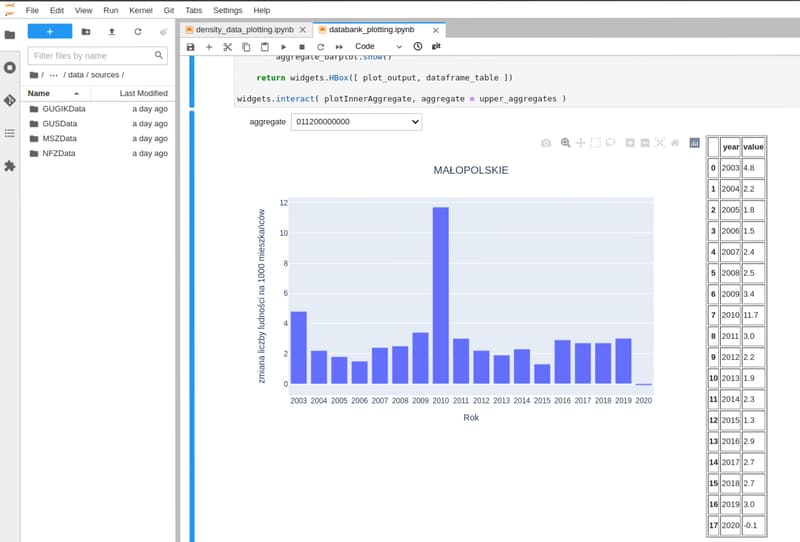
Presentation of usage of the JupyterHub application available as part of the computing cloud TASKcloud for the visualization of statistical data downloaded from the Local Database of the Polish Central Statistical Office
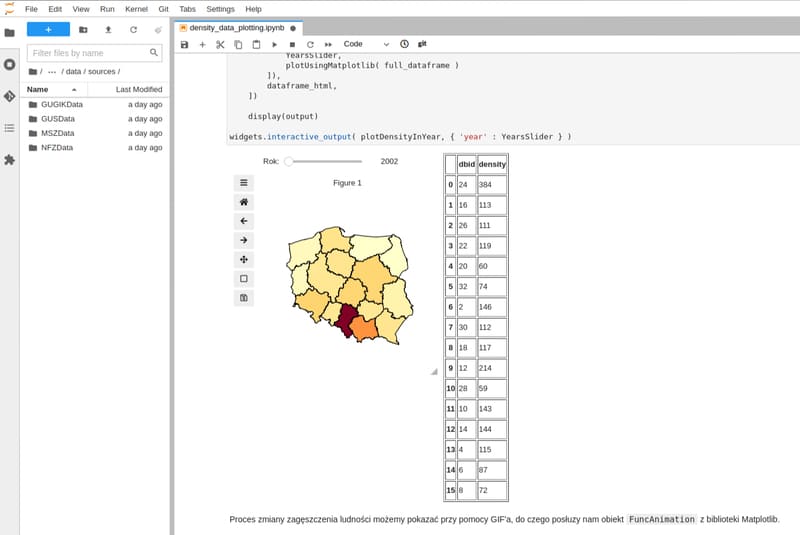
An example of a heatap
6
Big Data analysis
Managing an increasing amount of generated data is a contemporary challenge and comes down to many new Big Data solutions.
find out more
Big Data is a huge amount of digital data, necessary to obtain new information or necessary knowledge to make correct decisions or develop the right recommendations. For this purpose, adequate data sources must be indicated, appropriate rules for their collection and storage, as well as appropriate algorithms for their analysis (see figure). Popular Big Data technologies are offered by platforms such as: Jupiter, Hadoop or Spark; databases, e.g.: SQL (warehouses) such as Cassandra or Mango DB; Kafka or Flink data streaming; and machine learning support: Keros or Tensorflow. It is also important to visualize the analyzed data, which facilitates their understanding and simplifies their interpretation
The exponential increase in the amount of collected data, as well as the increase in the complexity of IT problems solved, requires new technological solutions. In particular, ensuring safe access to data sources (IoE) and to efficient computer networks (data transfer), as well as to large computing powers (supercomputers and cloud computing). The construction of SMART services requires the use of artificial intelligence algorithms ensuring scalability of calculations, as well as friendly environments for their production. An example of an interdisciplinary approach is the cooperation between CI TASK and Chopin Telewizja Kablowa sp.z o.o. (Project Partner), which will jointly purchase and modify probes allowing for the transmission of the image and a wide range of environmental parameters, thus creating an individually adapted virtual image of the state of the natural environment, with particular emphasis on areas attractive for tourists. It will be a demonstrator related to research in the area of the Internet of Things (IoT), using the new LoRaWAN research and measurement infrastructure (details in the Applications tab). In turn, due to the importance of Big Data technology, a new department dealing with this type of issues will be created at CI TASK.
